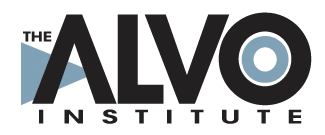By Andrea Strosberg
Instructional Design and Support Specialist, The Alvo Institute
Yes, there are more moving parts to a blended lesson plan than what teachers might be used to. This top 10 list contains some lesson plan elements that will sound familiar, as well as some dimensions of plans unique to blended learning, giving a glimpse of the big picture as well as several jumping-off points for educators who want to begin the gradual—and rewarding—shift toward BL.
1. Alignment
Simply: blended learning is standards-based, and each lesson’s objectives should be aligned according to whatever a school’s chosen standards are. This part of the lesson plan won’t change with a shift to blended learning.
2. Objectives
Blended learning lesson plans, however, usually include multiple objectives, which empowers teachers to plan lessons that allow each student to work toward individual goals. Therefore, there is forward momentum for students who have already mastered an objective as well as for those who aren’t ready to learn it yet.
3. Data
Data drives instruction. Whether that means reflecting on informal observations of students’ work, analyzing test scores, or consulting a sophisticated learning management system (LMS), the content of today’s lessons should flow from the assessment of yesterday’s learning, not just from a set list of objectives.
4. Grouping
With multiple objectives for a class period or block of time in mind (see #5), teachers should divide the class into well thought-out, yet flexible groups. The teacher might design activities that allow all members of the group to share the same objectives (homogenous grouping) or for students of varying readiness levels to accomplish individualized learning goals at the same time (heterogeneous grouping).
5. Blocking
Some teachers using blended learning think about planning in blocks: a specified group of students will meet several targeted objectives by working on a range of selected activities over a few days (the “block”). Teachers can plan for the common reality that it might take more than one class period for a student to learn skill X and account for the fact that the same student might master skill Y in a shorter time. Students may revisit one skill in several different rotations over the course of that block of time. Personalizing learning in this way helps to relieve the pressure to complete the textbook by the end of the year, or to cover certain material by the time the state test rolls around – a timetable that rarely serves all students.
6. Micro-environments
Instead of delivering one-size-fits-all frontal or lecture-style teaching each day, blended learning is about providing a range of instructional experiences—micro-environments—for students. Teachers just beginning to integrate blended learning techniques will start by incorporating small group learning into their normal class routine. More advanced blended learning classrooms contain several types of micro-environments, including small group work stations, computer-based learning, teacher-led small groups, instructional aide-led tutoring, individual work areas, and a whole-class space. Then, the question is: Which micro-environments will help which students accomplish their objectives?
(It’s tempting to list technology as its own dimension of lesson planning, but the integration of technology, usually through online learning providers (OLPs), comprises but one of the micro-environments teachers will use, and one that should be integrated after teachers are comfortable with most of the other micro-environments listed above.)
7. Activities
Many teachers are relieved to learn that they can still reach into the file cabinet for that hefty binder containing their best lessons from the past ten years. The difference now is that not all students will be doing all (or the same) activities. Teachers must be selective and prioritize activities for individuals or groups of students according to their specific needs. This is also when to consider the depth and areas of focus for the content chosen.
8. Timing
We tell kids, “it doesn’t have to be equal to be fair,” and that’s true when it comes to allotting time in a blended learning lesson plan. If one small group needs 20 minutes to accomplish their goals on the computer three times a week, and another group would benefit from more time at a hands-on problem-solving station, that’s what should be worked into the lesson plan. To start out, teachers will want to divide time more or less evenly, but as the personalization of instruction deepens, they will adjust students’ time in the various micro-environments according to their different needs.
9. Assessment
When planning a lesson, it’s important to specify how students and their learning will be assessed. The teacher needs to know when students have met their objectives for a given lesson. Planning for short-term formative assessments as well as a larger goal, like a unit test or final project enables progress-tracking for each student.
10. Organization
By now, it’s apparent that a blended learning lesson plan demands a little more space than the typical-size box given per class period in a weekly planner grid. It’s worth trying out a couple of different lesson planning templates specially made to accommodate the complexities of designing and organizing instruction in a blended learning classroom. Consider joining one of Alvo’s upcoming webinars on BL lesson planning to walk through the process using our favorite templates.
